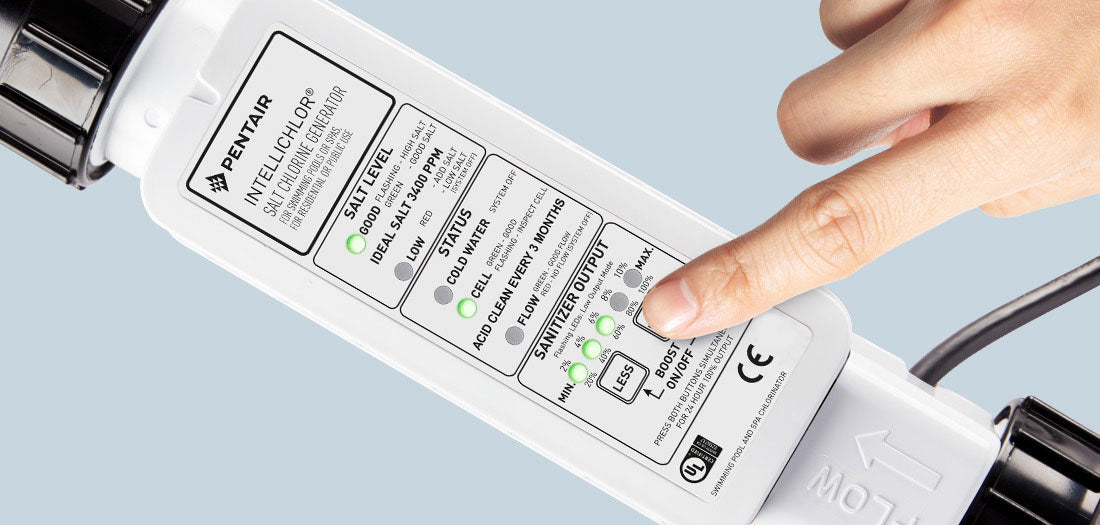Need a new salt cell or other service for your pool? Schedule online or contact us!
🧪 How to Tell if Your Pool Salt Cell is Working (or Needs Replacement)
Salt systems are great for low-maintenance pool sanitization — but when your chlorine levels are low, it can be tricky to tell whether the salt cell is to blame or if something else is going on.
This guide will help you:
-
Troubleshoot your salt chlorine generator
-
Understand error codes or warnings
-
Decide if the cell needs cleaning or replacement
✅ Step 1: Check Basic Water Chemistry
Before you assume the salt cell is the issue, test the water for:
-
Free chlorine (should be 1–3 ppm)
-
Salt level (check your manual, typically 2700–3400 ppm)
-
Stabilizer (CYA) (should be 30–50 ppm for salt pools)
-
pH and Alkalinity — high levels can reduce chlorine effectiveness
⚠️ If your stabilizer (CYA) is too low, chlorine produced by the cell will quickly be destroyed by sunlight — even if the salt cell is working perfectly.
🔍 Step 2: Check the Salt System Display for Error Codes
Most modern salt chlorinators will show one or more of the following messages:
-
Low salt
-
No flow
-
Check/clean cell
-
High salt
-
Cell off
Follow the manufacturer's manual for what the message means. A common issue is incorrect salt readings due to dirty or aging sensors.
If your system says “Low Salt” but you’ve tested and it's normal, the sensor may need cleaning or calibration.
🧼 Step 3: Inspect and Clean the Salt Cell
If the display says “Check Cell”, remove the cell and inspect for:
-
White chalky scale buildup
-
Visible corrosion or missing plates
-
Clogged openings
To clean the cell:
-
Turn off power and remove the cell.
-
Soak in a cell cleaning solution (usually 4:1 water to muriatic acid) for 5–10 minutes.
-
Rinse thoroughly and reinstall.
Only clean when necessary — excessive cleaning can reduce cell lifespan.
⚡ Step 4: Confirm the Cell is Actually Producing Chlorine
To check if the salt cell is generating chlorine:
-
Turn the system on and set it to 100% output.
-
Let it run for 15–30 minutes.
-
Use a chlorine test strip near a return jet (where water re-enters the pool).
-
If the reading is higher near the return than in the rest of the pool — it’s producing chlorine.
No chlorine at the return = possible bad cell or control board issue.
🧰 Step 5: Additional Troubleshooting Tips
If everything looks clean but you're still having problems:
-
Check flow sensor — make sure pump is primed and water is moving.
-
Make sure the system has enough runtime — salt cells only produce chlorine while the pump is running.
-
Inspect cable connections — loose or corroded connections can stop chlorine production.
-
Have the cell tested — some pool stores can test output using a test station.
❌ When to Replace the Salt Cell
Salt cells typically last 3–7 years, depending on:
-
Usage
-
Water balance
-
Cleaning frequency
-
Brand/model
Signs it’s time to replace:
-
“Cell Off” or “No Chlorine Production” despite cleaning
-
Error codes that persist even after troubleshooting
-
Damaged or worn electrode plates
-
Cell test shows zero chlorine output
📝 Summary: Salt Cell Troubleshooting Checklist
| ✅ Checkpoint | What to Do |
|---|---|
| Water chemistry | Test chlorine, salt, CYA, pH |
| Display panel | Review error messages |
| Cell condition | Look for scale, damage |
| Output test | Check for chlorine at return jet |
| Runtime & flow | Ensure pump runs long enough and has proper flow |
| Cell age | Over 5 years? May be time to replace |
Need Help?
If you're unsure, we're happy to help walk you through it or schedule a service call.
📞 Contact Premier Pool & Spa — or stop by with your cell and we'll help you determine if it needs cleaning or replacement.





